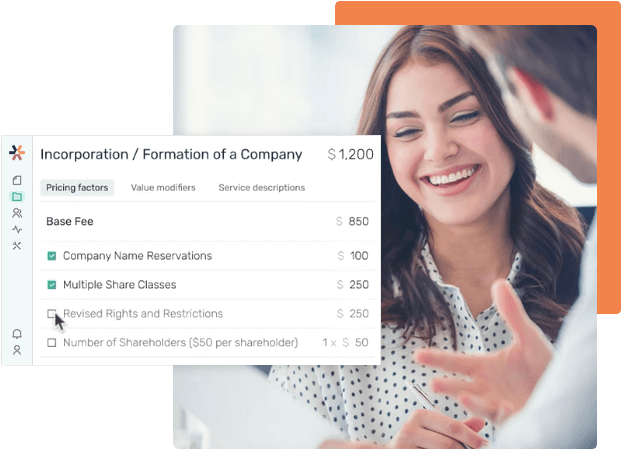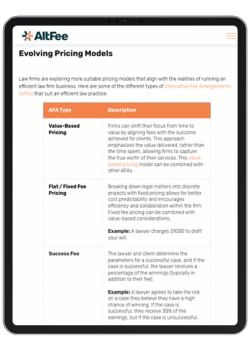- Resources
- Legal Services Sliding Fee Scale: Pros, Cons, & Alternatives
Table of Contents
There is definitely rhetoric out there that paints lawyers as these money-hungry, nickel-and-diming people. But before you shoot the messenger, know these attitudes are rapidly changing. At the end of the day, most people become lawyers because they want to help people navigate the law and ensure that justice is served rather than strictly because of a high paycheck.
Another traditional aspect of the law that’s changing is the use of the billable hour due to the fact that newer generations of lawyers are entering the legal space, and they simply don’t want to experience the burnout and long hours that their predecessors have endured. But a stronger, more important reason is that the billable hour doesn’t convey value as well as alternative fee arrangements (AFAs) do. In short, AFAs prioritize the value that a legal professional provides, rather than the time that they spend on a legal matter.
This article explores sliding scale fees further and offers insight into how and when they can be used as a value-based pricing method.
What Is a Sliding Fee Scale?
A sliding fee scale is a pricing arrangement that a law firm or solo practitioner offers to a client based on where they fall within Federal Poverty Guidelines.
Of course, a sliding fee scale can be used in other industries for various services, but for the purposes of this article, we’ll discuss a sliding scale fee within the context of law firms.
What are Sliding Fee Scales for Law Firms?
The idea behind a sliding fee scale is that if someone falls in the low-income earnings bracket for their country or region and needs access to legal services, then a lawyer or law firm will charge the client a lesser fee that’s more affordable.
In theory, a sliding fee scale sounds like a great idea, but there’s a big problem with it: there are no fixed rates for legal services in Canada or the United States.
Instead, there are overarching rules and guidelines (set by the Canadian Bar Association in Canada, as well as individual law societies and the American Bar Association in the United States) that indicate that legal fees charged by lawyers and law firms must be “fair and reasonable”. The definitions surrounding what “fair and reasonable” mean consist of costs to the law firm or lawyer to take on the case, level of experience, the complexity of the case, and more. But the key takeaway is that there’s no real benchmark for how much a certain legal matter should cost, so lawyers and law firms can still charge what they feel is necessary, so long as it can be justified as “fair and reasonable.”
This isn’t to say that a law firm or a lawyer would intentionally charge a low-income person a higher rate, but only that there’s no baseline for the low-income person to determine what is a “good” rate and what isn’t without putting the burden on them to do additional research.
Advantages and Disadvantages of a Legal Sliding Scale Fee
To gain a better understanding of the high-level advantages and disadvantages of sliding scale fees, consider the following table:
| Pros |
Cons |
| May offer increased access to justice |
May contribute to price discrimination |
| Easy framework to use to adjust existing rates |
Legal fees aren’t wholly regulated; instead legal services must be “reasonable and fair”, which still in effect means that law firms and lawyers can charge what they wish, meaning a low-income person will still need to do price research |
| Easy to explain and offer to clients |
Can potentially devalue a service |
| Clients may recognize a sliding scale fee as an affordable option, attracting more clients to the firm |
Likely not as effective at increasing access to affordable legal services compared to other AFAs. |
Advantages of Using a Sliding Scale Fee
There are several reasons why it would be advantageous for a law firm or solo practitioner to use sliding scale fees. The main advantages are outlined below.
1. It May Offer Increased Access to Justice
While community and charitable organizations provide a lot of support in helping people receive access to legal services that they would not be able to afford otherwise, it’s nowhere near enough. In Canada, for instance, discussions are happening at various levels, including government and law societies, pertaining to how awareness and changes to the legal system can be made to help Canadians better understand where and when they can receive help with legal services. Specifically, Canada's access to justice conversation is based on the overarching themes in the UN’s Sustainable Development Goal 16 (SDG 16). The United States has similar conversations and initiatives, specifically with the Office for Access to Justice organization within the U.S. Department of Justice.
An important aspect evident from these ongoing conversations is that collaboration is required between the government, law firms, and legal professionals. Offering a sliding fee scale is just one way legal organizations can contribute to increased access to justice.
Organizations that bill by the hour may consider offering reduced rates based on a sliding scale to low-income clients in an effort to increase access to justice. But for organizations that offer AFAS, in many ways, they’ve already removed barriers that may prevent someone from accessing legal services by providing upfront pricing and a variety of pricing options (e.g., flat fees, phased fees, success fees, etc.) and, therefore, better price certainty. That being said, an AFA law firm could still incorporate a sliding scale with their AFA fees if they felt it would benefit them.
2. Easy Framework to Use to Adjust Existing Rates
Best practice for charging sliding scale fees for law firms is to consider the client’s overall ability to pay—often determined by their family size and income level, assumed from the Federal Poverty Guidelines in either the United States or Canada. Using these sources of income and family information, law firms and solo practitioners can easily calculate a rate that makes sense for low-income clients.
For example, one firm called the Community Lawyers of Iowa, offers a sliding scale fee based on a client’s percentage of income versus the FPL (Federal Poverty Guidelines) for the state of Iowa.
To illustrate how this works, here is an example:
- A two-person household brings in $45,000 per year
- By simply entering that amount into the provided FPL calculator, the client can see that their income percentage is just over 320% of the FPL.
- In this case, the law firm will provide a discounted rate of $228.19 per hour versus their regular rate of $250 (note that this specific number for this law firm has been used for example purposes only and is subject to change).
3. Easy to Explain and Offer to Clients
Because sliding scale fees are easy to calculate and it is easy to show the reasoning behind them, they are easy to explain to clients. Sliding scale fee calculators are easy enough to find online (the link in the previous point is an example), or one can be easily created for your law firm using a program like Excel or Google Sheets. As long as a service has a set price, whether through hourly rates or an AFA like a flat fee, it’s easy to calculate a sliding fee scale for that service. Other types of AFAs are likely better to be offered as is for the service instead of including a sliding scale fee on top of it.
4. Clients May Recognize Sliding Scale Fees as an Affordable Option
One positive aspect of offering legal sliding scale fees is that clients that fall within the low-income bracket may seek out firms or solo practitioners that offer them, as a sliding fee scale may be a signifier to these clients that the legal services offered will be affordable for them. If you’re a firm or a solo practitioner looking to attract a wide variety of clients, then offering a sliding fee scale may be beneficial.
Further, if other law firms in your area offer sliding scale fees, it would be beneficial for you to look into offering them to stay competitive.
Disadvantages of Using a Sliding Scale Fee
Although there are benefits to offering a sliding fee scale for different legal services, it may not be the best course of action for every single service or every single client. Here are some disadvantages to offering a sliding scale fee.
1. May Contribute to Price Discrimination
As a common practice within microeconomics, price discrimination occurs when different prices are charged to different buyers of the same good or service. This is done because people have different abilities or willingness to pay.
The very name “price discrimination” has an implication of being negative and unfair, but that’s obviously not the intention behind using sliding scale fees. Rather, it’s so that more people can access legal services without the lawyer or law firm being expected to work for free. However, depending on your point of view and the fact that legal services pricing isn’t regulated, using sliding scale fees can be seen as a form of price discrimination.
There are technically three different ways that price discrimination can occur:
- First-degree price discrimination occurs when a business sells a product or service for the maximum possible price. This is pretty standard for most businesses, as they do market research to determine the highest possible price they can charge.
- Second-degree price discrimination is also known as product versioning or menu pricing and is when a company charges different prices based on how many products or services are purchased at one time by a customer. For example, if a customer purchases products in bulk, they may receive a cheaper price per unit than a customer who only purchases one of the same product.
- Third-degree price discrimination is also known as group pricing and is when a company charges a different price based on the group the customer is from, such as students, veterans, seniors, etc. This is the category where the sliding fee scale falls into, as the intention is to charge a lesser price for clients that fall into the low-income group.
Like any charitable intention, there’s fear that sliding scale fees will be taken advantage of, or that individuals who can afford to pay more will feel like they were “scammed” because someone else paid less for the same service. This is especially true with firms that transparently advertise their sliding scale pricing on their website; that transparency could potentially backfire and result in upset clients.
In any case, firms or solo practitioners need to be thoughtful about how they present their sliding scale fees should they decide to use them and ensure that adequate research is conducted to establish that a sliding fee scale program is the best option.
2. Pricing with Sliding Scales isn’t Regulated
Consumers of legal services should be aware that since the cost of legal services isn’t regulated in Canada or the United States, law firms that use sliding scale fees may not necessarily be offering a price that’s considered affordable for that client. The onus is put on the client to do their own research and compare prices for different lawyers.
3. Can Potentially Devalue a Service
The discussion surrounding AFAs for legal services is all about how lawyers can showcase the value of their services. Because offering a sliding fee scale is essentially the same thing as offering a discount, some lawyers may view it as contributing to devaluing their services.
4. May Not Be as Effective In Providing Affordable Legal Services as Other AFAs
Offering other AFAs in place of a sliding fee scale may provide more affordable options for clients that make more sense. For example, a contingency fee is one of the most affordable AFAs because the client typically has to pay nothing (the lawyer is paid with a percentage of the settlement) or very little. Unbundled legal services are another option, where the client can pick and choose the legal services they need to be handled by a lawyer and handle the rest themselves. In this case, the firm would typically charge a flat rate for the service, making the transaction very straightforward.
How to Determine Sliding Scale Fees
Now that we’ve gone over the pros and cons of sliding scale fees, let’s take a step back and go over how lawyers can determine what a sliding scale fee should be.
Research the Typical Rates for Legal Services in Your Area
Chances are research about legal fee pricing in your area has been conducted by yourself or others in your firm already. Still, it’s always a good idea to revisit this research periodically. It might be more difficult to find specific pricing if most of the firms in your area use AFAs, but consulting with colleagues and others in your network to get an educated pricing estimate is always a good idea.
AltFee allows legal professionals to collaborate on matter pricing within one centralized environment. Users can add comments and replies to specific legal matter pricing guidelines, providing their expertise and insight and facilitate discussion to make pricing more accurate Because communications are kept in one place, it’s easy for everyone to stay on the same page in terms of current discussions on matter pricing for each client.
Analytics included in the software allows decision-makers to quickly identify trends and patterns with historical matter pricing, allowing for better, more educated future-focused business decisions to be made.
By using the included pricing templates, firms can easily implement AFA pricing or improve their existing AFA pricing simply by making small tweaks to the templates. With this robust starting point, your firm can offer value-based pricing to clients sooner and with more confidence right out of the gate.
Start Earning More Revenue with Fixed Fees
Break free from hourly pricing and take the fear out of scoping and pricing client projects to start maximizing profitability.
Book A Demo
Determine the Client’s Income Level
After researching pricing and implementing an AFA pricing tool like AltFee, the next step in determining a sliding fee scale is to learn about the client’s income level.
From there, the FPL chart for the United States, or Market Basket Measure (MBM) in Canada, can be used as a baseline to determine how much a client should be charged, typically based on a percentage above the low-income level they make annually.
Determine How Much to Charge Based on Income Level
The client’s income level plays a part in determining the percentage discount off the firm’s regular price for the legal service. By using the FPL or MBM chart as a baseline, firms can determine how much of a discount they want to give a client based on their income level and apply that percentage as a static number to all services. For example, a firm could decide that clients that fall within the lowest level of income received a 40% discount on each individual service that they choose. Most firms seem to keep their percentages simple (e.g., 10%, 20%, 30%) to make it easier to set pricing.
If your firm uses AFAs, law firm pricing software like AltFee makes systemizing your pricing templates easy and effective and even has a dedicated feature to help firms account for value-based pricing considerations like a client qualifying for a percentage discount.
Firms can also choose to follow pre-determined fees set by organizations like JusticeNet to make setting pricing for different services for low-income clients easier.
JusticeNet is an organization that lawyers in Ontario can join to offer a centralized location where individuals who could otherwise not afford legal services can access them. Lawyers who join use JusticeNet’s reduced fee schedule to provide cost consistency and transparency for clients, no matter which lawyer or law firm they hire.
JusticeNet’s reduced fee schedule for lawyers is as follows:
| Net Yearly Family Income |
Number of Dependents & Hourly Rate* |
||
| 3+ |
2 |
0-1 |
|
| Under $40,000 |
$120 |
$120 |
$120 |
| $40,000 – $49,000 |
$120 |
$130 |
$140 |
| $50,000 – $59,000 |
$130 |
$140 |
$160 |
| $60,000 – $69,000 |
$140 |
$160 |
$180 |
| $70,000 – $90,000 |
$190 |
$190 |
|
*Represents JusticeNet’s recommended cost to the client based on income level and level of dependents. The number indicated in the table is the recommended billable hour rate if the firm bills by the hour.
Individuals can view lawyer’s fees and information on their legal practice via a profile page before deciding which lawyer to hire.
Should Your Law Firm Use Sliding Scale Fees?
Whether your firm should use a sliding fee scale for all legal services or some legal services can be broken down into a few main factors:
- If your firm uses the hourly billing model and you are looking for an easy transition into offering more affordable services for your lower-income clients, a sliding fee scale is an easy framework to use.
- If your firm uses a variety of AFAs to price legal services, then chances are the pricing you’ve set represents the value for service accurately. However, sliding scale fees provide a useful tool for firms to use to potentially adjust their AFA pricing for low income clients, making legal services more affordable for them.
- If most other law firms in your area offer sliding fee scale pricing and you want to remain competitive, it may be necessary to implement this pricing structure into your practice.
Alternatives for Sliding Scale Attorney Fees
While offering a sliding fee scale may work for some law firms, it may not be the best choice for others. There is a variety of AFAs that law firms can choose to implement that provide a low or no-cost alternative to standard legal fees, including:
Contingency Fee
A contingency fee is often an attractive option for clients as well as lawyers, as long as the client has a case that the lawyer is confident they can win. With a contingency fee, the client doesn’t pay their lawyer unless the lawyer wins the case. And if the lawyer does win the case, they take a percentage of the settlement amount.
There are a few additional things to know about contingency fees, including:
- The percentage amount the lawyer will receive upon winning the case is predetermined and agreed upon by the lawyer and the client before work commences.
- Contingency fees have different rules and regulations regarding what types of cases they can be used for. Criminal cases, divorce cases, and family law matters are examples of situations where using a contingency fee for payment would typically not be allowed.
- There are different types of contingency fees, including fixed percentage (the attorney is paid a singular amount), staged or graduated (payment changes based on the stage the case gets to, for instance, if the case doesn’t reach trial, then the payment would be different compared to if the case did reach trial), and holdbacks (where the lawyer is paid a percentage of their fee at the beginning of the matter, and then paid the remaining percentage at the end of the matter based on the client’s satisfaction and outcome).
The final contingency fee type is a success fee, which we’ll discuss in the next section.
Success Fee
Another type of contingency fee is called a success fee. With a success fee, a predetermined amount of money is paid to the lawyer before the case, and the rest of the payment is contingent upon whether the case is won or not. With a success fee, the case risk is somewhat split between the client and the lawyer, so it might be a more attractive option than a traditional contingency fee for a lawyer who is not 100% sure if they can win a case.
Unbundled Legal Services
Sometimes, clients have cases where they can handle some of the legal requirements themselves, but other aspects of the case need the assistance of a lawyer. If the client has limited funds, firms and solo practitioners can choose to offer an unbundled legal service. This is where the lawyer provides a very specific legal service, like contract review, for example, at a flat rate, with the understanding that the client will handle the rest of the process themselves. It’s important that the client understands exactly what they will receive with an unbundled legal service and that they also understand that there are aspects of their matter that they will have to handle themselves without the assistance of a lawyer.
How AltFee Supports Management of Sliding Scale Fees
Although AFAs are increasing in usage, there are gaps in how to manage AFA pricing effectively.
AltFee is a pricing solution that allows firms and solo practitioners to effectively manage their AFA pricing strategies, including sliding scale fees. AltFee uses historical billing data and subject matter expert insight to build out template pricing guidelines, which lawyers and firms can then use as the starting point to scope and price projects. Firms can utilize the notes and update requests features within AltFee to encourage discussion and optimization of pricing templates among team members.
Start Earning More Revenue with Fixed Fees
Break free from hourly pricing and take the fear out of scoping and pricing client projects to start maximizing profitability.
Book A Demo
Conclusion
As a type of AFA, the idea behind a sliding fee scale is to increase access to justice for those with a lower income bracket. Whether to use a sliding fee scale or implement other types of AFA within a law firm depends on the clientele, the firm’s current pricing and billing, and the competition in the area.
Managing AFAs can be complex without the right software. AltFee was specifically designed to help law firms easily manage their AFAs with one robust tool that’s easy to onboard. Give AltFee a try today. Get a Demo.







Newsletter Signup
Subscribe to our newsletter to receive the latest news.


